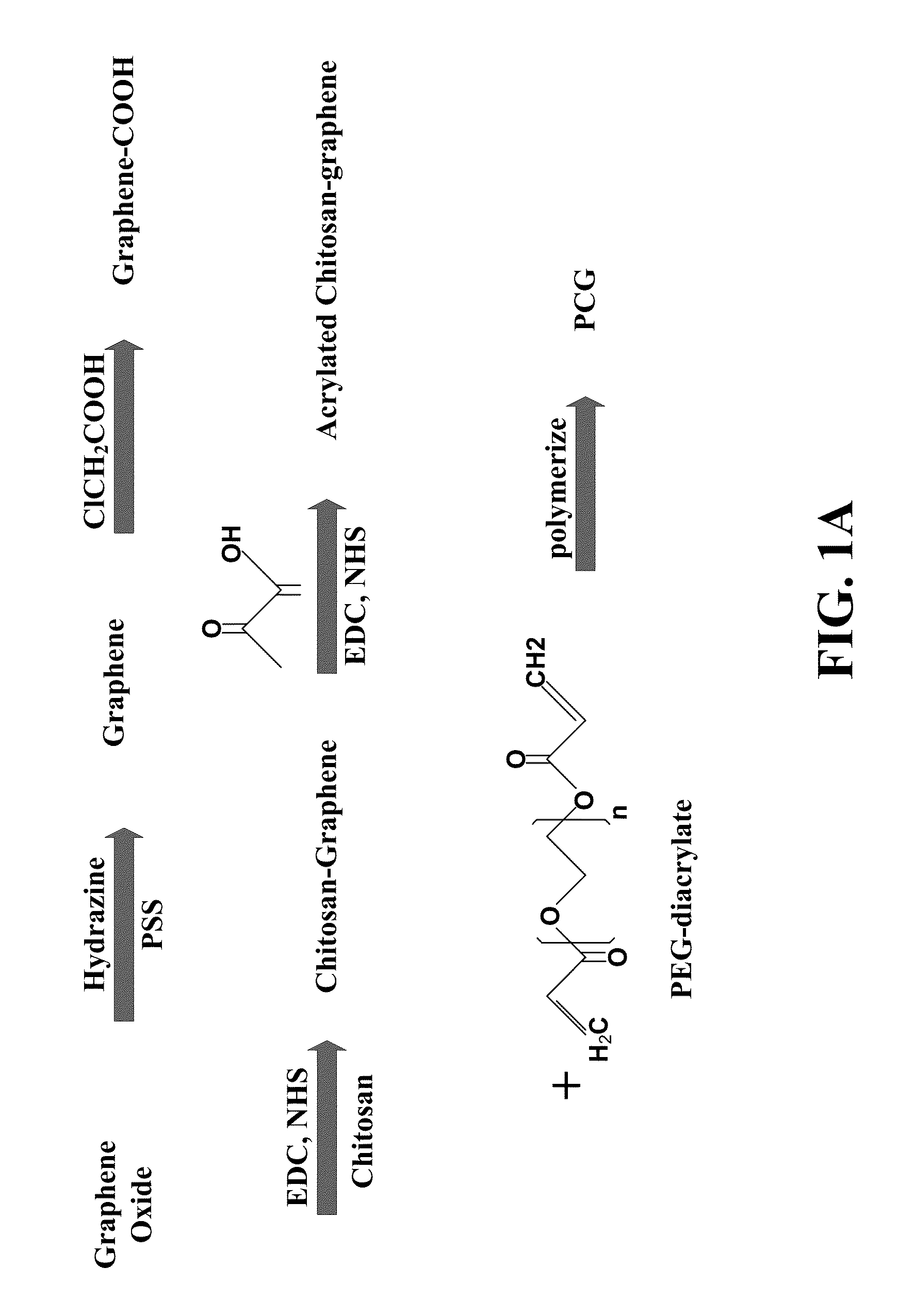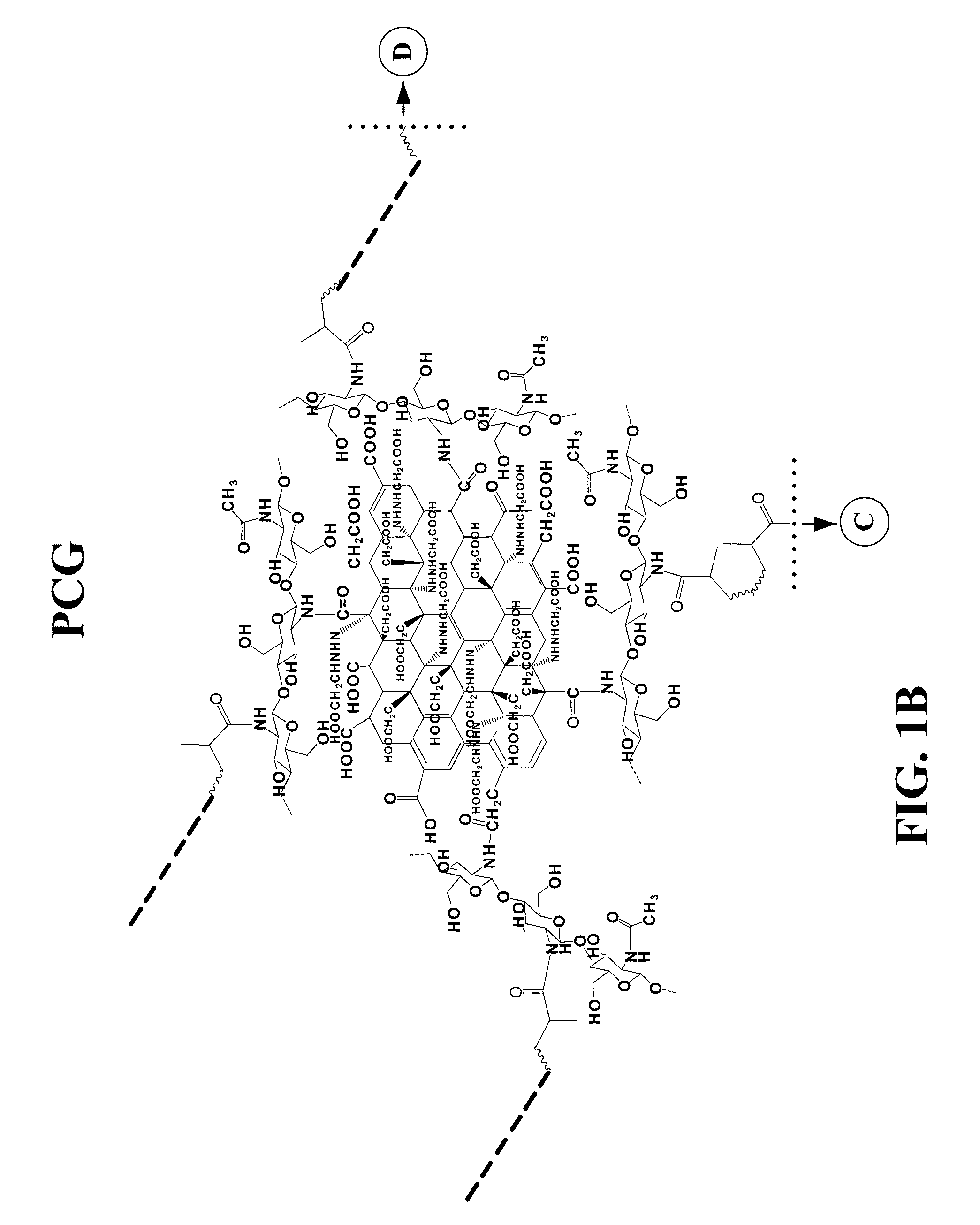Graphene hydrogel and method for using the same
a technology of graphene hydrogel and hydrogel, which is applied in the field of hydrogels, can solve the problems of poor results obtained when growing cells in monolayers, no delivery systems have been advanced to clinical trials,
- Summary
- Abstract
- Description
- Claims
- Application Information
AI Technical Summary
Benefits of technology
Problems solved by technology
Method used
Image
Examples
example 1
Preparation and Characterization of PCG Hydrogel
[0081]A PCG hydrogel was prepared based on a chitosan modified graphene and poly(ethylene glycol) (PEG) according to FIG. 1. To increase the carboxylic acid groups on the surface of graphene sheets, graphene oxide was first reduced to graphene and then reacted with ClCH2COOH. Chitosan was covalently bonded to graphene via amide bond by reacting the amine groups of chitosan with the COOH groups of graphene in the presence of EDC and NHS. The chitosan functionalied graphene was further reacted with acrylic acid to form an acrylated chitosan-graphene monomer which was crosslinked with PEGDA to form PEG-Chitosan-Graphene hydrogel.
[0082]More specifically, the following materials were used: Graphene oxide 0.5% water solution (Angstron Materials Inc., OH, USA), water soluble chitosan (Mw, 10 kDa) was donated from Transgenex Nanobiotech Inc. Poly (ethylene glycol) diacrylate (PEGDA), Tetramethylethylenediamine (TEMED), Ammonium persulphate (AP...
example 2
Cell Viability and Morphology of Cells Placed on a PCG Hydrogel
[0094]The cell morphology on the monolayer, PEG hydrogel, PC hydrogel, PG, and PCG hydrogel was investigated with Calcein AM staining (data not shown). The cells cultured on monolayer form a spindle-shape. On four hydrogels the cells are fine and form the rounded shape. The proliferation rates of BM-MSC on PG and PCG hydrogel decreased compared to PEG and PC hydrogels. There are two possible reasons for this observation: (1) graphene is cytotoxic or (2) BM-MSCs differentiate into other lineages because of the unique properties of the graphene incorporated into the hydrogel. From the EthD-1 staining, it can be seen that BM-MSCs on graphene incorporated hydrogel PG and PCG is more biocompatible than PEG or PC hydrogel. This indicates that the cytotoxicity of graphene is not the main reason for the lower proliferation rate of BM-MSCs on graphene incorporated hydrogel. The big nodules and connection between nodules was also ...
example 3
Adipogenic Differentiation of Cells Placed on a PCG Hydrogel
[0095]The adipogenic differentiation of MSCs on the hydrogels described herein was determined by specifically staining intra-cytoplasmic lipids with Oil Red O and quantifying these lipids by normalizing the total area of lipid droplets per cell. Without the differentiation medium, no adipogenesis was observed on the hydrogel (data not shown). Compared to a monolayer, 3D hydrogel demonstrated intensive staining Compared to the PEG hydrogel and PEG-chitosan hydrogel, the PCG hydrogel showed the most lipid droplets and exhibited the highest levels of oil red O staining See FIG. 6. Accordingly, graphene incorporated into 3D hydrogel significantly enhanced the adipogenic differentiation instead of inhibiting such differentiation as seen with graphene materials in the prior art. These results suggest potential applications of graphene-chitosan-PEG hydrogel for adipose tissue regeneration. FIG. 7 also demonstrates that the PCG hyd...
PUM
| Property | Measurement | Unit |
|---|---|---|
| molecular weight | aaaaa | aaaaa |
| temperature | aaaaa | aaaaa |
| molecular weight | aaaaa | aaaaa |
Abstract
Description
Claims
Application Information
 Login to View More
Login to View More - R&D
- Intellectual Property
- Life Sciences
- Materials
- Tech Scout
- Unparalleled Data Quality
- Higher Quality Content
- 60% Fewer Hallucinations
Browse by: Latest US Patents, China's latest patents, Technical Efficacy Thesaurus, Application Domain, Technology Topic, Popular Technical Reports.
© 2025 PatSnap. All rights reserved.Legal|Privacy policy|Modern Slavery Act Transparency Statement|Sitemap|About US| Contact US: help@patsnap.com



